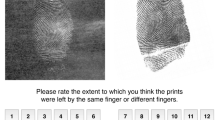Abstract
The paper briefly describes results of empirical study on performance (as measured by ROC) and throughput (as measured by number of matches per sec) of multimodal biometrics. We use cascaded multimodal biometric identification. Experiments show that cascaded multimodal biometric fusion improves both throughput and performance.
Similar content being viewed by others
References
A. Ross and N. Poh, “Multibiometric: Overview, Case Studies, and Open Issues,” in Handbook of Remote Biometrics, Ed. by M. Tistarelli, et al. (Springer, 2009), pp. 273–292.
P. Griffin, “Optimal Biometric Fusion for Identy Verification,” Identix Research Tech. Rep. No. RDNJ-03-0064 (2004).
K. Nandakumar, Y. Chen, S. C. Dass, and A. K. Jain, “Likelihood Ratio Based Biometric Score Fusion,” IEEE Trans. Pattern Anal. Mach. Intell. 30(2), 342–347 (2008).
S. O. Novikov and O. S. Ushmaev, “Biometric Fusion: Robust Approach,” in Proc. 2nd Workshop on Multimodal User Authentication (Toulouse, 2006), Available from: http//mmua.cs.ucsb.edu/MMUA2006/Papers/127.pdf
L. I. Kuncheva, Combining Pattern Classifiers-Methods and Algorithms (Wiley, New York, 2004).
E. S. Bigun, J. Bigun, B. Duc, and S. Fischer, “Expert Conciliation for Multimodal Person Authentication Systems Using Bayesian Statistics,” in Proc. 1st Int. Conf. on Audio- and Video-Based Biometric Person Authentication (AVBPA) (Crans-Montana, 1997), 291–300.
A. K. Jain, K. Nandakumar, and A. Ross, “Score Normalization in Multimodal Biometric Systems,” Pattern Recogn. 8(12), 2270–2285 (2005).
J. Kittler, N. Poh, O. Fatukasi, K. Messer, K. Kryszczuk, J. Richiardi, and A. Drygajlo, “Quality Dependent Fusion of Intramodal and Multimodal Biometric Experts,” in Proc. SPIE Defense and Security Symp., Workshop on Biometric Technology for Human Identification (Orlando, 2007), Vol. 6539.
J. Neyman and E. S. Pearson, “On the Problem of the Most Efficient Tests of Statistical Hypotheses,” Phil. Trans. Roy. Soc. L. Ser. A 231, 289–337 (1933).
Biolink AMIS, Available from: http://www.biolinkso-lutions.com/products/software/AMIS/
NIST Biometric Scores Set, Release 1, Available from: http://www.itl.nist.gov/iad/894.03/biometricscores/
Author information
Authors and Affiliations
Corresponding author
Additional information
The article is published in the original.
Oleg S. Ushmaev received the MS degree in Math from Lomonosov Moscow State University in 2002 and the PhD degree in Computer Science in 2004, and the doctoral degree in 010 from the Institute of Informatics Problems, Russian Academy of Sciences. He is leading scientist in the Institute of Informatics Problems. Until 2009 he worked as R&D Director with fingerprint vendor Biolink Solutions. His research interests include multimodal biometrics, fingerprint recognition and statistical pattern recognition.
Igor N. Sinitsyn Doctor of Sciences, professor, head of the Institute of Informatics Problems, Russian Academy of Sciences. He is the author of more than 500 publications, including 50 books, and 30 patents.
Rights and permissions
About this article
Cite this article
Ushmaev, O., Sinitsyn, I. Multimodal biometrics: Empirical study of performance-throughput trade-off. Pattern Recognit. Image Anal. 21, 754–758 (2011). https://doi.org/10.1134/S1054661811040183
Received:
Published:
Issue Date:
DOI: https://doi.org/10.1134/S1054661811040183



